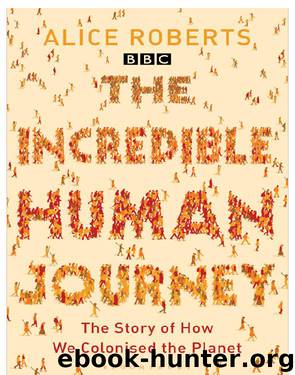The Incredible Human Journey by Alice Roberts

Author:Alice Roberts
Language: eng
Format: epub, mobi
Publisher: Bloomsbury Publishing
Published: 2000-01-01T16:00:00+00:00
An Archaeological Puzzle: Zhujiatun, China
From around 1,000,000 to 30,000 years ago, the stone tools of East Asia are predominantly fairly crude, Oldowan-style pebble and flake tools. The archaeology of this part of the world is particularly strange, when viewed from a European perspective. The Acheulean, with its classic hand axes, doesn’t really happen, and neither does the Middle Palaeolithic.1, 2 People just seem to carry on using really basic pebble tools that even Neanderthals would have considered crude. In 1955, this moved American archaeologist Hallam Movius deprecatingly to call the East ‘a marginal area of cultural retardation’.3
It’s not until 30,000 years ago, in the late Upper Pleistocene, that the Upper Palaeolithic appears in China, with more sophisticated tools like end-scrapers, burins, blades and microblades, as well as tools made from bone and antler. But that transition happened some 20,000 to 30,000 years after genetic estimates for the arrival of modern humans in East Asia, and a good 10,000 years after the first fossil evidence of modern humans in China.4 Before then, the tools the modern humans were making were no different from the tools made by earlier archaic humans in the East. It was this persistence of pebble tools – the so-called ‘chopper-chopping’ technology – that Wu interpreted as archaeological evidence for regional continuity. If all we had to look at were the stone tools, then regional continuity does seem like a reasonable explanation.
But if the balance of evidence favours a recent African origin for modern humans, and if we take those dates from the genetic and fossil record, suggesting a colonisation of South-East and East Asia by (presumably ingenious and adaptable) modern humans between 40,000 and 60,000 years ago, then why were they putting so little thought into their tools? Were they really culturally retarded, or had Movius missed the real technology of Palaeolithic East Asia?
Palaeolithic archaeology is a difficult area just because so little is left behind. As I had seen in Siberia, it was possible to erect a comfortable home, live in it, then move on without leaving any clue for future archaeologists to uncover. Archaeological clues in prehistory are rare and precious. As for tools, anything made out of something we would now consider as biodegradable – wood, other plant materials, animal skin – is by its very nature going to disappear from the archaeological record.
Some archaeologists believe that the riddle of stone tools in East Asia could be explained by something that is both biodegradable and ubiquitous in the region. I met up with Australian archaeologist Jo Kamminga and we made our way to the small village of Zhujiatun in southern China, to find out more about this theory.
Jo had armed himself with a selection of typical pebble and flake tools. I had a look at one of them.
‘This is a fairly crude tool,’ I observed.
‘Well, this is what we find in China, and South-East Asia, and in Australia as well. It’s not beautifully shaped, but it’s incredibly sharp,’ said Jo.
‘But at the end of
Download
The Incredible Human Journey by Alice Roberts.mobi
This site does not store any files on its server. We only index and link to content provided by other sites. Please contact the content providers to delete copyright contents if any and email us, we'll remove relevant links or contents immediately.
| Anatomy | Animals |
| Bacteriology | Biochemistry |
| Bioelectricity | Bioinformatics |
| Biology | Biophysics |
| Biotechnology | Botany |
| Ecology | Genetics |
| Paleontology | Plants |
| Taxonomic Classification | Zoology |
Sapiens: A Brief History of Humankind by Yuval Noah Harari(14311)
The Tidewater Tales by John Barth(12625)
Mastermind: How to Think Like Sherlock Holmes by Maria Konnikova(7274)
Do No Harm Stories of Life, Death and Brain Surgery by Henry Marsh(6904)
The Thirst by Nesbo Jo(6876)
Why We Sleep: Unlocking the Power of Sleep and Dreams by Matthew Walker(6649)
Life 3.0: Being Human in the Age of Artificial Intelligence by Tegmark Max(5506)
Sapiens by Yuval Noah Harari(5320)
The Longevity Diet by Valter Longo(5038)
The Body: A Guide for Occupants by Bill Bryson(5025)
The Rules Do Not Apply by Ariel Levy(4906)
The Immortal Life of Henrietta Lacks by Rebecca Skloot(4547)
Animal Frequency by Melissa Alvarez(4424)
Why We Sleep by Matthew Walker(4393)
The Hacking of the American Mind by Robert H. Lustig(4334)
Yoga Anatomy by Kaminoff Leslie(4331)
All Creatures Great and Small by James Herriot(4266)
Double Down (Diary of a Wimpy Kid Book 11) by Jeff Kinney(4239)
Embedded Programming with Modern C++ Cookbook by Igor Viarheichyk(4136)
